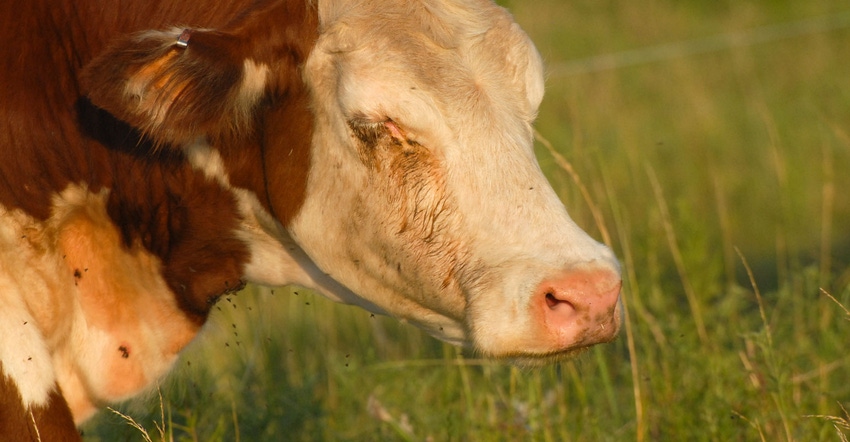Experts say prevention is the best method to protect your beef herd against pinkeye.

Pinkeye is one of the most common diseases of beef cattle, but a more potent strain has popped up in Pennsylvania this year.
Moraxella bovoculi is a more aggressive version of pinkeye, according to Dan Kniffen, assistant professor of animal science at Penn State.
“I have visited with one local vet group in our area and they said they have been getting quite a few more calls than normal, and many of the cases prove to be bovoculi,” Kniffen says.
Once it gets in a herd, it moves at a higher rate of speed than the more common form of pinkeye, Moraxella bovis. It’s also less responsive to treatments, and outbreaks can last weeks at a time, Kniffen says.
Many factors can predispose cattle to pinkeye and lead to development of the disease, according to Michigan State University Extension. These include irritation of the eyes from cattle walking and grazing; dust accumulation in the eyes; face flies; and ultraviolet sunlight. Certain breeds such as Herefords, Hereford crosses, Charolais and even some Holsteins lack pigment on their eyelids, which makes them more susceptible because of their sensitivity to sunlight.
Calves are even more susceptible to it since they have not developed protective antibodies on the eye surface, and bull calves have a higher incidence of disease than calves.
“Depending on level of infection in one or both eyes, the infection can have a significant impact on intake and subsequent production. Specific intake changes would be animal-specific,” says Kevin Gould, Extension beef educator at Michigan State.
Antibiotic treatment is usually recommended for treatment, but Gould says some strains of pinkeye have developed resistance. He says that patching infected eyes at an early stage of the disease can be helpful to reduce eye irritation and speed up healing.
Left untreated, pinkeye will result in eye scaring and complete loss of sight in severe cases, he says.
“If both eyes are infected, cattle can become totally blind and need to be confined to prevent injury,” he says.
Prevention is key
Since many things help to cause pinkeye in the first place, limiting those are key to prevent infection.
Mike Baker, beef cattle Extension specialist at Cornell, says he’s seen spotty incidence of disease this season.
One farm he went to recently had a 30% rate of infection. Another farm he went to had less than 10% rate of infection. Others had no infection at all.
“Given the abundance of flies and tall under-grazed pasture, I would have guessed a major increase, but I am not seeing that,” he says.
Baker provided five tips for producers to help prevent an infection:
1. Provide strong immunity. This may or may not mean vaccination for pinkeye. A complete vaccination for the viruses can be effective in strengthening the overall immune system, making it more capable of fighting infection. As always, consult your veterinarian.
2. Provide a complete diet. Diets that are deficient in protein, energy, minerals and vitamins are more prone to support infection. Provide a loose mineral that contains 6% phosphorous, supplemented with copper and selenium.
3. Control flies. Neither flies nor tall grass alone cause pinkeye, but if the bacteria exists then flies will spread it. Flies can travel as far as two miles, so surrounding farms can be a source of infection.
Controlling face flies is a challenge, but several methods in combination are most effective.
4. Keep herd closed during grazing. Avoid bringing in new animals prior to grazing season.
Pinkeye is caused by several strains of bacteria, and some animal resistance has been shown to develop. Bringing in new animals can bring a strain of bacteria that your cattle are not resistant to.
If you do not vaccinate your animals for pinkeye, you may want to consider vaccinating new animals.
5. Treat early. Early treatment is a must. Once the eye has clouded over, permanent damage is most likely. If infection rate is 20% or greater, mass treatment may be in order.
Where practical, patching the eye(s) helps keep flies from spreading infection and relieves the pain of bright sunlight.
Keeping a close eye on the pasture and keeping animals away from problem areas is also key. Kniffen says that tall, dry grass seed heads tend to become dislodged from the plant and end up in the eyes of cattle, especially calves.
Dust, plant pollen or weed seeds will promote tearing from the eyes. As a result, bacteria will also be shed.
Eye irritation can be caused by any plants that have awns, he says. The awns can cause significant irritation as they stick in the eye and eventually lodge.
About the Author(s)
You May Also Like





